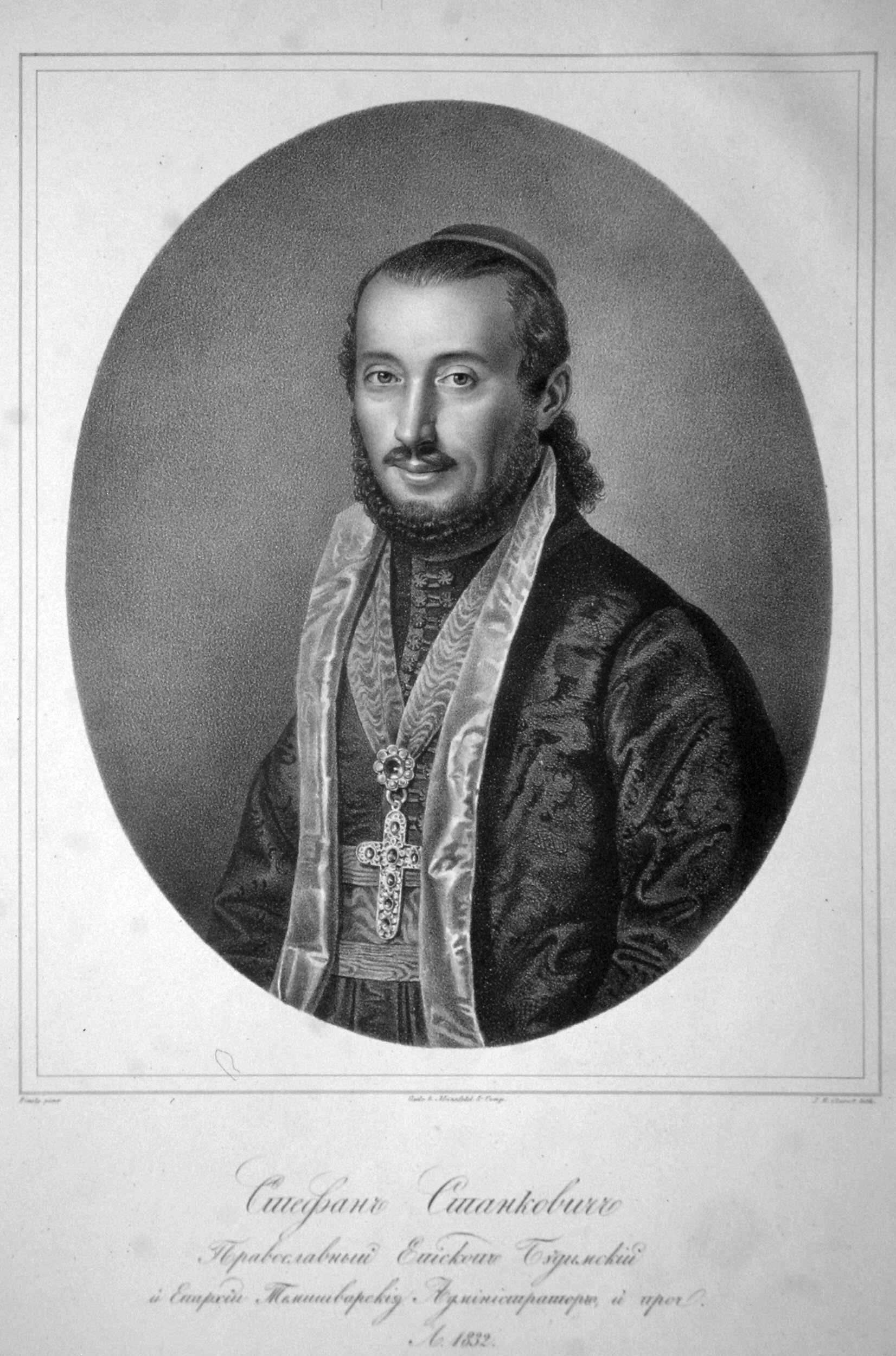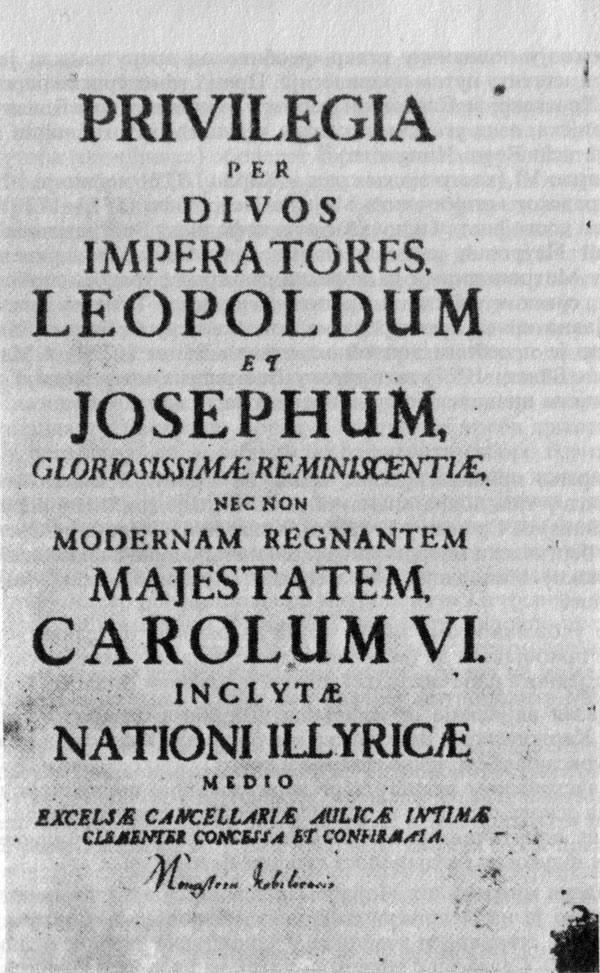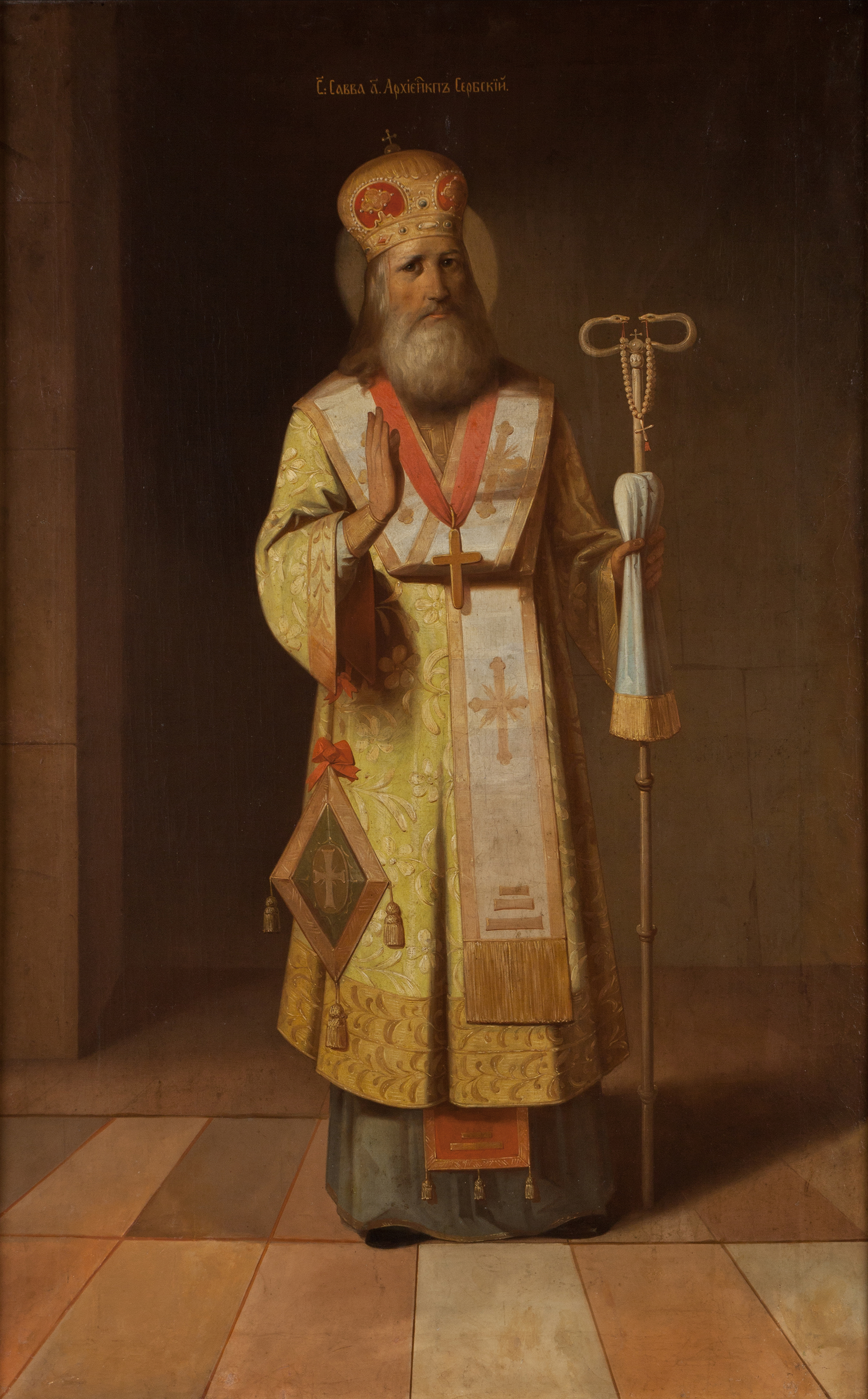|
Stefan Stanković
Stefan Stanković (( sr, Стефан Станковић; Sremski Karlovci, Austrian Empire, 24 June 1788 - Sremski Karlovci, Austrian Empire, 31 July 1841) was a Serbian Orthodox bishop from the Eparchy of Budaand Metropolitan of Karlovci from 1836 to 1841, succeeding Stefan Stratimirović. He was succeeded by Metropolitan Josif Rajačić. Biography He was born in Sremski Karlovci to parents Stojko and Pelagija. He completed his high school education in Sremski Karlovci and the Faculty of Philosophy at the University of Pest. In 1807 Metropolitan Stefan Stratimirović appointed him professor in Karlovci. He was ordained deacon on December 25, 1808, by the Bishop Josif Putnik of the Eparchy of Pakrac. Bishop Josif (Putnik) was sympathetic to Stanković and helped him move ahead. Josif took him with him to Croatia, to Pakrac where he received the bishop's throne. He was promoted to the rank of Protodeacon on August 15, 1809, at Lepavina Monastery. He went to the Rakovac monastery ... [...More Info...] [...Related Items...] OR: [Wikipedia] [Google] [Baidu] |
Stephan Stankovic Litho
Stephan may refer to: * Stephan, South Dakota, United States * Stephan (given name), a masculine given name * Stephan (surname), a Breton-language surname See also * Sankt-Stephan * Stefan (other) * Stephan-Oterma * Stephani * Stephen (other) Stephen is a masculine given name. Stephen may also refer to: People * Stephen (surname), including a list of people with the surname * Stephen (honorific), a South Slavic medieval honorific Places * Stephen, Minnesota, United States * Mount S ... * von Stephan {{disambiguation ... [...More Info...] [...Related Items...] OR: [Wikipedia] [Google] [Baidu] |
Orahovac
Rahovec ( sq-definite, Rahoveci) or Orahovac (Serbian Cyrillic: Ораховац) is a town and municipality located in the District of Prizren in western Kosovo. According to the 2011 census, the town of Rahovec has 15,892 inhabitants, while the municipality has 56,208 inhabitants. Name The Serbian name of the town, ''Orahovac'', is derived from the Serbian '' orah'', meaning "walnut". The Albanian name ''Rahovec'' comes from an Albanised pronunciation of ''Orahovac''. Ernst Eichler considers that the toponym delivers from Albanian term ''rrah'', which delivers from Illyrian. Geography and population The municipality covers an area of approximately and contains 35 villages. In 2014 the town had a total population of 23,200 and the population of the municipality was 58,214.Municipal Profile: Rahovec/Orahovac . Org ... [...More Info...] [...Related Items...] OR: [Wikipedia] [Google] [Baidu] |
Metropolitans Of Karlovci
The Metropolitanate of Karlovci ( sr, Карловачка митрополија, Karlovačka mitropolija) was a metropolitanate of the Eastern Orthodox Church that existed in the Habsburg monarchy between 1708 and 1848. Between 1708 and 1713, it was known as the Metropolitanate of Krušedol, and between 1713 and 1848, as the Metropolitanate of Karlovci. In 1848, it was elevated to the Patriarchate of Karlovci, which existed until 1920, when it was merged with the Metropolitanate of Belgrade and other Eastern Orthodox jurisdictions in the newly established Kingdom of Serbs, Croats and Slovenes to form the Serbian Orthodox Church. History During the 16th and 17th centuries, all of the southern and central parts of the former medieval Kingdom of Hungary were under Turkish rule and organized as Ottoman Hungary. Since 1557, Serbian Orthodox Church in those regions was under jurisdiction of the Serbian Patriarchate of Peć. During the Austro-Turkish War (1683–1699), much of th ... [...More Info...] [...Related Items...] OR: [Wikipedia] [Google] [Baidu] |
Georgije Hranislav
Georgije Hransislav (secular Gavrilo Hranislav; 8 November 1775 - 22 June 1843) was the bishop of the Serbian Orthodox Church. Biography Bishop Georgije was born as Gavrilo Hranislav in Ruma on 8 November 1775, to father Pavle and mother Alka. He studied basic sciences with local teachers in Ruma. In the period 1787-1791, he attended a Slav-Serbian school. He studied high school in Karlovac and Novi Sad, and then was at the Academy in Varaždin, listening to philosophy. In the end, he attended postgraduate classes in law and philosophy in Pest and Vienna. Monastic life From 1804, Gavrilo Hranislav was a professor at the grammar school in Karlovac until 1812, when Metropolitan Stefan Stratimirović promoted him to the rank of deacon on 6 October, and then protodeacon on 31 January 1813 and archdeacon on 21 November 1814. He became a close associate of the Metropolitan Stefan. Gavrilo Hranislav accepted monasticism on 11 January 1816 in the monastery of Krušedol by the archi ... [...More Info...] [...Related Items...] OR: [Wikipedia] [Google] [Baidu] |
Eparchy Of Bačka
The Eparchy of Bačka ( sr, Бачка епархија, Bačka eparhija) is an ecclesiastical territory or eparchy of the Serbian Orthodox Church in the Bačka region, Serbia. It is situated in the autonomous province of Vojvodina and the seat of the eparchy is at Saint George's Cathedral in Novi Sad. History The eparchy was established in the 16th century. In the beginning, the seat of the bishop was in Segedin (today in Hungary). It was later moved to monasteries of Bačka, and was finally stabilized in Novi Sad in the beginning of the 18th century. Seems that between the second half of the 16th century and the second half of the 17th century, the Eparchy was a Metropolitanate, since its administrators in this time period are mentioned with metropolitan title. Territory The eparchy includes entire Serbian part of Bačka, but also has supreme authority over some territories in present-day Hungary, including counties Bács-Kiskun ( Baja), Csongrád (Szeged) and Heves (Eger) ... [...More Info...] [...Related Items...] OR: [Wikipedia] [Google] [Baidu] |
Gedeon Petrović
Gideon (; ) also named Jerubbaal and Jerubbesheth, was a military leader, judge and prophet whose calling and victory over the Midianites are recounted in of the Book of Judges in the Hebrew Bible. Gideon was the son of Joash, from the Abiezrite clan in the tribe of Manasseh and lived in Ephra (Ophrah). As a leader of the Israelites, he won a decisive victory over a Midianite army despite a vast numerical disadvantage, leading a troop of 300 "valiant" men. Archaeologists in southern Israel have found a 3,100-year-old fragment of a jug with five letters written in ink that appear to represent the name Jerubbaal, or Yeruba'al. Names The nineteenth-century Strong's Concordance derives the name "Jerubbaal" from "Baal will contend", in accordance with the folk etymology, given in . According to biblical scholar Lester Grabbe (2007), " udges6.32 gives a nonsensical etymology of his name; it means something like 'Let Baal be great. Likewise, where Strong gave the meaning "hewer" t ... [...More Info...] [...Related Items...] OR: [Wikipedia] [Google] [Baidu] |
List Of Heads Of The Serbian Orthodox Church
This article lists the heads of the Serbian Orthodox Church, since the establishment of the church as an autocephalous archbishopric in 1219 to today's patriarchate. The list includes all the archbishops and patriarchs that led the Serbian Orthodox Church under the Serbian Archbishopric and Serbian Patriarchate of Peć. Today, the church is unified under a patriarch who is officially styled as ''Archbishop of Peć, Metropolitan of Belgrade and Karlovci, and Serbian Patriarch'' ( sr, Архиепископ пећки, митрополит београдско-карловачки, и патријарх српски, Arhiepiskop pećki, mitropolit beogradsko-karlovački, i patrijarh srpski). According to the current constitution of the Serbian Orthodox Church, the patriarch is elected by a special convocation of the Bishops' Council,Article 43 of the Constitution of 1957. and serves as the chairman of the Holy Synod.Article 58 of the Constitution of 1957. The current patriarch is ... [...More Info...] [...Related Items...] OR: [Wikipedia] [Google] [Baidu] |
Metropolitanate Of Karlovci
The Metropolitanate of Karlovci ( sr, Карловачка митрополија, Karlovačka mitropolija) was a metropolitanate of the Eastern Orthodox Church that existed in the Habsburg monarchy between 1708 and 1848. Between 1708 and 1713, it was known as the Metropolitanate of Krušedol, and between 1713 and 1848, as the Metropolitanate of Karlovci. In 1848, it was elevated to the Patriarchate of Karlovci, which existed until 1920, when it was merged with the Metropolitanate of Belgrade and other Eastern Orthodox jurisdictions in the newly established Kingdom of Serbs, Croats and Slovenes to form the Serbian Orthodox Church. History During the 16th and 17th centuries, all of the southern and central parts of the former medieval Kingdom of Hungary (1301–1526), Kingdom of Hungary were under Turkish rule and organized as Ottoman Hungary. Since 1557, Serbian Orthodox Church in those regions was under jurisdiction of the Serbian Patriarchate of Peć. During the Great Turk ... [...More Info...] [...Related Items...] OR: [Wikipedia] [Google] [Baidu] |
Dimitrije Avramović
Dimitrije "Mita" Avramović (Serbian Cyrillic: Димитрије Мита Митриновић; 15 March 1815 – 1 March 1855) was a Serbian writer, iconographer, caricaturist and painter in the Neoclassical style, considered to be the preeminent painter of the era and best known for his iconostasis and frescos. Avramović also translated from German into Serbian Johann Joachim Winckelmann's ''Geschichte der Kunst des Alterthums'' ("The History of Art in Antiquity") and other writings. He is considered the father of modern comic strips in Serbia. His caricatures were used to fight against the authoritarian rule of the masses in both the Austrian Empire and the Ottoman Empire at the time. Biography He was born in Šajkaš, where he, as a boy, moved with his family to Novi Sad where he started schooling. In 1833 he went to Vienna for the first time, then again in 1835. He studied painting in Vienna privately with Friedrich Amerling, and then in 1836 to 1839 he was enrolled a ... [...More Info...] [...Related Items...] OR: [Wikipedia] [Google] [Baidu] |
Vuk Karadžić
Vuk Stefanović Karadžić ( sr-Cyrl, Вук Стефановић Караџић, ; 6 November 1787 (26 October OS)7 February 1864) was a Serbian philologist, anthropologist and linguist. He was one of the most important reformers of the modern Serbian language. For his collection and preservation of Serbian folktales, ''Encyclopædia Britannica'' labelled him "the father of Serbian folk-literature scholarship." He was also the author of the first Serbian dictionary in the new reformed language. In addition, he translated the New Testament into the reformed form of the Serbian spelling and language. He was well known abroad and familiar to Jacob Grimm, Johann Wolfgang von Goethe and historian Leopold von Ranke. Karadžić was the primary source for Ranke's ''Die serbische Revolution'' (" The Serbian Revolution"), written in 1829. Biography Early life Vuk Karadžić was born to a Serbian family of Stefan and Jegda (née ''Zrnić'') in the village of Tršić, near Loznica, ... [...More Info...] [...Related Items...] OR: [Wikipedia] [Google] [Baidu] |






